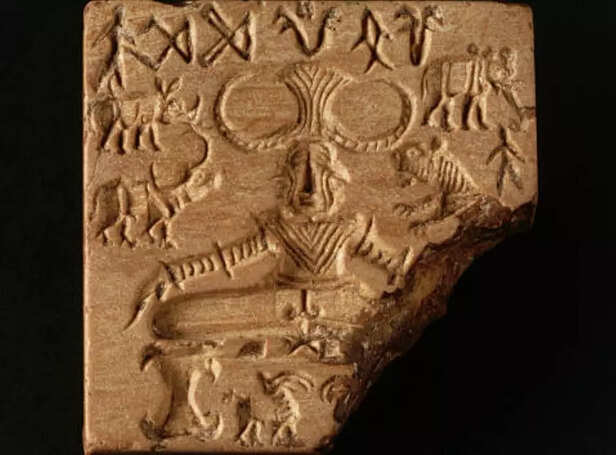Kalpa Vigraha— 28,450-Year-Old Lord Shiva Idol That Proves Shiva Was Always Here
Ankit Gupta | May 22, 2025, 22:29 IST
Lord Shiva
( Image credit : Pixabay )
Whether myth, misunderstood science, or authentic artifact, the Kalpa Vigraha challenges the very foundations of human history and spirituality. It reminds us that there may be chapters of civilization and divine connection lost in the sands of time, waiting to be rediscovered.
In a world constantly rewriting its past, some artifacts appear like echoes from a forgotten age—challenging everything we think we know about history, religion, and the origins of civilization. One such object is the Kalpa Vigraha, a mysterious idol believed by some to be the oldest known image of Lord Shiva—carbon-dated to an astonishing 26,450 BCE.
If this claim holds true, the Kalpa Vigraha isn't just an archaeological anomaly—it is a revelation. It suggests that a deeply spiritual, Shiva-centric culture may have existed over 28,000 years ago, long before the Indus Valley Civilization, Sumerians, or even Stonehenge. Mainstream history, however, remains skeptical.
But is it merely legend, or is there more to the Kalpa Vigraha than scholars are willing to admit?

According to scattered reports and researcher testimonies, the Kalpa Vigraha was discovered in the Tibetan plateau, possibly near the ancient spiritual corridors connecting Mount Kailash, Lake Mansarovar, and the broader regions where Bon, Shaivism, and Tantric traditions once flourished.
The idol is reportedly just a few inches tall, depicting a serene, meditative Shiva-like figure seated in a yogic posture. What sets it apart is not just the iconography but the metal composition—a mix of unknown alloys not found in modern metallurgy databases. Early private studies described it as "non-rusting, unusually heavy for its size, and giving off an electromagnetic aura."
It was allegedly brought to the United States in the late 20th century by a private collector, and that’s where the first scientific testing took place.

In what has become the most debated aspect of this artifact, a radiocarbon dating test was supposedly conducted on organic remnants near or attached to the idol—such as residue or an organic base, perhaps once part of its pedestal. The result: over 28,000 years old.
For perspective, this date pushes the artifact back to the Upper Paleolithic period, when most of humanity was still in the hunter-gatherer stage and supposedly incapable of creating metal idols or complex spiritual systems.
But here's the catch: this claim has never been published in a peer-reviewed journal. Most references to the dating come from fringe researchers, independent reports, or spiritual circles fascinated by ancient Shiva worship. No verified academic institution has released comprehensive test data, and the idol's current location remains uncertain—possibly in a private collection or hidden from public access.
Still, the shockwaves from that one date—26,450 BCE—refuse to die down.

The possibility that Lord Shiva was venerated tens of thousands of years ago opens up a radically different timeline for Indic civilization. While historians place Vedic texts at around 1500–1200 BCE and the Indus Valley Civilization around 3300–1300 BCE, the Kalpa Vigraha could potentially prove that Shiva worship predates both by over 20,000 years.
Interestingly, even mainstream archaeology has found phallic symbols (lingams) and proto-yogic figurines in Mohenjo-daro and Harappa, dated around 2500 BCE. These were once controversially associated with Proto-Shiva or the Pashupati seal—a horned yogic figure many believe is an early depiction of Shiva.
Could the Kalpa Vigraha be the original archetype of all such symbols—a divine relic from an age when gods still walked among men?
One of the most fascinating aspects of the Kalpa Vigraha is its metal composition. Researchers claimed it contained traces of rare-earth elements, and at least one analysis suggested it included radioactive isotopes stabilized in a way unknown to modern science.
Some alternative historians speculate this could be evidence of lost advanced technology, comparable to the legends of Vimanas, Atlantean metallurgy, or even extraterrestrial contact. While these theories lack academic proof, they reflect a growing global interest in the intersection of myth and material reality.
Could ancient Rishis have accessed knowledge that modern scientists are only beginning to uncover? Or is the idol simply a brilliant hoax that fed on the mystical allure of the Himalayas?
The name "Kalpa" itself is deeply symbolic. In Sanskrit, a Kalpa refers to a cosmic aeon—a full day in the life of Brahma, equal to 4.32 billion years. Naming the idol "Kalpa Vigraha" implies it represents not just Shiva, but Shiva in his timeless, eternal form—a being who transcends cycles of creation and destruction.
This ties into the Advaitic and Tantric conceptions of Shiva—not merely as a god, but as the unchanging substratum of reality, the first yogi, and the absolute stillness beyond time.
If we take the claims seriously, the Kalpa Vigraha could be evidence of a lost civilization rooted in Shiva consciousness. Legends abound in Himalayan and Tamil traditions of Kumari Kandam, Shambhala, and other ancient lands where Tapasya, Yogic knowledge, and divine sciences were passed down before being submerged or forgotten.
In these myths, Lord Shiva is often the center—not just as a deity, but as a teacher of cosmic laws, the lord of time (Mahakaal), and the first guru (Adi Guru) of all wisdom.
Could the Kalpa Vigraha be a surviving relic of that lost Shaiva world?
Until the Kalpa Vigraha is studied openly under modern archaeological scrutiny—with full publication of its location, materials, dating methods, and provenance—it remains in the twilight realm between fact and legend.
But its story resonates because it taps into a deep cultural memory—that Lord Shiva has always been with us, far beyond historical boundaries. Whether through the lingams in caves, the yogic postures of Indus seals, or now, perhaps, through a tiny metal idol lost in Tibet, the spiritual call of Shiva seems eternal.
The Kalpa Vigraha may or may not turn out to be the oldest idol of Lord Shiva—but it has already achieved something greater: it has reignited the imagination of a people hungry to rediscover their past.
In an age obsessed with modernity, perhaps this relic reminds us that spirituality, devotion, and the quest for truth are older than civilization itself.
Whether locked in a vault, hidden in a cave, or embedded in our collective subconscious, the Kalpa Vigraha whispers to us across millennia:
"Shiva was always here."
If this claim holds true, the Kalpa Vigraha isn't just an archaeological anomaly—it is a revelation. It suggests that a deeply spiritual, Shiva-centric culture may have existed over 28,000 years ago, long before the Indus Valley Civilization, Sumerians, or even Stonehenge. Mainstream history, however, remains skeptical.
But is it merely legend, or is there more to the Kalpa Vigraha than scholars are willing to admit?
Discovery in the Himalayas

Tibetan Connection
( Image credit : Freepik )
According to scattered reports and researcher testimonies, the Kalpa Vigraha was discovered in the Tibetan plateau, possibly near the ancient spiritual corridors connecting Mount Kailash, Lake Mansarovar, and the broader regions where Bon, Shaivism, and Tantric traditions once flourished.
The idol is reportedly just a few inches tall, depicting a serene, meditative Shiva-like figure seated in a yogic posture. What sets it apart is not just the iconography but the metal composition—a mix of unknown alloys not found in modern metallurgy databases. Early private studies described it as "non-rusting, unusually heavy for its size, and giving off an electromagnetic aura."
It was allegedly brought to the United States in the late 20th century by a private collector, and that’s where the first scientific testing took place.
The Radiocarbon Shock

26,450 BCE?
( Image credit : Getty Editorial )
In what has become the most debated aspect of this artifact, a radiocarbon dating test was supposedly conducted on organic remnants near or attached to the idol—such as residue or an organic base, perhaps once part of its pedestal. The result: over 28,000 years old.
For perspective, this date pushes the artifact back to the Upper Paleolithic period, when most of humanity was still in the hunter-gatherer stage and supposedly incapable of creating metal idols or complex spiritual systems.
But here's the catch: this claim has never been published in a peer-reviewed journal. Most references to the dating come from fringe researchers, independent reports, or spiritual circles fascinated by ancient Shiva worship. No verified academic institution has released comprehensive test data, and the idol's current location remains uncertain—possibly in a private collection or hidden from public access.
Still, the shockwaves from that one date—26,450 BCE—refuse to die down.
Shiva Worship in Prehistoric Times?

Pashupati Seal
( Image credit : Getty Editorial )
The possibility that Lord Shiva was venerated tens of thousands of years ago opens up a radically different timeline for Indic civilization. While historians place Vedic texts at around 1500–1200 BCE and the Indus Valley Civilization around 3300–1300 BCE, the Kalpa Vigraha could potentially prove that Shiva worship predates both by over 20,000 years.
Interestingly, even mainstream archaeology has found phallic symbols (lingams) and proto-yogic figurines in Mohenjo-daro and Harappa, dated around 2500 BCE. These were once controversially associated with Proto-Shiva or the Pashupati seal—a horned yogic figure many believe is an early depiction of Shiva.
Could the Kalpa Vigraha be the original archetype of all such symbols—a divine relic from an age when gods still walked among men?
A Metal from Beyond Time
Some alternative historians speculate this could be evidence of lost advanced technology, comparable to the legends of Vimanas, Atlantean metallurgy, or even extraterrestrial contact. While these theories lack academic proof, they reflect a growing global interest in the intersection of myth and material reality.
Could ancient Rishis have accessed knowledge that modern scientists are only beginning to uncover? Or is the idol simply a brilliant hoax that fed on the mystical allure of the Himalayas?
Kalpa: A Name with Cosmic Meaning
This ties into the Advaitic and Tantric conceptions of Shiva—not merely as a god, but as the unchanging substratum of reality, the first yogi, and the absolute stillness beyond time.
Was There a Lost Shiva Civilization?
In these myths, Lord Shiva is often the center—not just as a deity, but as a teacher of cosmic laws, the lord of time (Mahakaal), and the first guru (Adi Guru) of all wisdom.
Could the Kalpa Vigraha be a surviving relic of that lost Shaiva world?
Between Faith and Fact: What Should We Believe?
But its story resonates because it taps into a deep cultural memory—that Lord Shiva has always been with us, far beyond historical boundaries. Whether through the lingams in caves, the yogic postures of Indus seals, or now, perhaps, through a tiny metal idol lost in Tibet, the spiritual call of Shiva seems eternal.
A Shiva Beyond Time
In an age obsessed with modernity, perhaps this relic reminds us that spirituality, devotion, and the quest for truth are older than civilization itself.
Whether locked in a vault, hidden in a cave, or embedded in our collective subconscious, the Kalpa Vigraha whispers to us across millennia:
"Shiva was always here."
